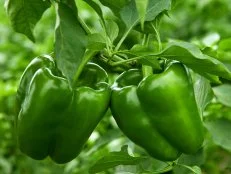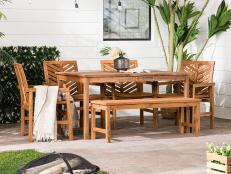What's Wrong With My Peppers?
Learn about common pepper problems — along with a few tips to make things right.

Julie A. Martens
How many pepper problems and non-problems can you identify in this photo? Learn how to diagnose common issues with your pepper plants and how to fix them.
Peppers are mostly a carefree crop. Give plants some sun and water, and you're on your way to a harvest of brightly colored fruit in a host of flavors, from sweet to sizzling.
Planting and Growing Bell Peppers
Grow delicious bell peppers from seed or seedlings with these expert tips on everything from planting peppers to harvesting.
Sometimes homegrown peppers encounter a few challenges. See our list of common pepper problems and learn ways to deal with — and prevent — these common pepper issues.

Julie Martens Forney
Pepper leaves most often turn yellow for one of three reasons: lack of nitrogen, overwatering or low temperatures.
Pepper Leaves are Turning Yellow
When plant leaves shift from green to yellow, something is wrong — and peppers are no exception. Most often, pepper leaves turn yellow for one of three reasons: lack of nitrogen, overwatering or low temperatures.
Lack of Nitrogen
Nitrogen fuels lush, green leaves. When pepper plants don't have enough nitrogen, leaves turn yellow, starting with the lowest, oldest leaf. That's because the plant is shifting nitrogen from the oldest leaves to new growth at the top of the plant. If the nitrogen issue isn't fixed, over time the next leaf up the stem will turn yellow and so on until the entire plant is yellow and looks sick. Yellow leaves eventually drop off the plant, again starting with the lowest, oldest leaves.
Feeding your pepper plant with an all-purpose fertilizer in liquid or granular form easily fixes the problem. A product labeled for tomatoes works well for peppers, too. After fertilizing the plant, pale green leaves may become darker green, but fully yellow leaves may not change. Note that if you consistently feed pepper plants too much nitrogen, you'll get lush leaf growth but few peppers. (See note on that below.)
Overwatering
Yellow pepper leaves also occur due to overwatering. In this scenario, yellow leaves appear first at the bottom of the plant. Your strategy should be to keep soil on the dry side. Leaves will wilt if the plant needs water, but it's not a good idea to let leaves wilt before each watering. Pepper plants won't yield well if they suffer from too much drought. Aim to strike a balance that prevents overwatering.
Low Temperatures
Peppers are tropical plants so temperatures below 50 degrees can cause leaves to turn yellow. If a cold snap occurs, you'll see yellowing leaves all over the plant, not just at the bottom. In late spring and fall, keep an eye on the weather forecast so you can protect your pepper plants with a frost blanket if needed. Look for a bag type with a drawstring so you can slip the bag over the plant and cinch it tight at the bottom to exclude cold air.
Buy Supplies

Julie A. Martens
Blame weather that's too cool when your pepper plants flower but don't produce fruit.
Pepper Plant Flowers But No Fruit
When healthy-looking pepper plants bloom but drop flowers without setting fruit, it's usually not your fault. Blame this one on the weather. Temps are probably too cold or too hot.
Set peppers out too early, and chilly air (nights below 58 degrees) causes blossoms to fall. When day temperatures creep over 90 degrees and nights stay above 75 degrees, blooms drop.
Once the hot spell passes, flower pollination should resume and peppers will form. Until then, keep plants well-watered and fertilized, so they're ready to jump back into production. Hot peppers handle hot weather better than bell types.

Julie A. Martens
Don’t panic if you see dark spots along pepper stems.
Dark Spots On Pepper Stems
If you spy dark spots — from deep purple to black — along pepper stems, don't panic. This actually is not a problem but a natural coloring that occurs. You'll see it most often at stem joints and where leaves and peppers attach to the main stem.
As long as the rest of the stem is solid, green and healthy, you have nothing to worry about. Just enjoy the show these colorful plants put on.

Julie A. Martens
Small holes in peppers indicate the work of voracious slugs.
Slugs On Peppers
Small holes in peppers are usually the work of slugs. The problem is, once slugs create an opening, other critters join the party, like pill bugs and earwigs. The wound in the fruit also invites early decay and mold.
Slugs attack low-hanging fruit first, but they also slime their way up pepper plants and supports. Research slug treatments and adopt several strategies to deal with them. When pepper season is done and before frost, continue to use slug treatments to kill adult slugs before they lay eggs.
13 Ways to Get Rid of Slugs
Slugs have a voracious appetite and reproduces like mad. Learn how to get rid of these eating machines.
Slugs don't just attack peppers, they also chew holes in leaves and make entire leaf edges disappear. Straw mulch provides a perfect place for slugs to hang out and reproduce. It's also a great mulch for vegetables. If you use it, consider putting out slug bait or traps to help keep the slimy critters in check.

Julie A. Martens
Blossom end rot is a common ailment on peppers that happens as a result of uneven watering (wet-dry cycles in soil), too-high nitrogen or root damage.
Blossom End Rot on Peppers
Those dark, sunken spots on the bottom of peppers are blossom end rot. It's so common that veggie growers often call it BER for short. It's not a disease but a symptom of calcium deficiency. It occurs due to uneven watering (wet-dry cycles in soil), too-high nitrogen or root damage.
You can eat peppers with BER — just cut the bottoms off. For a quick fix, treat plants with a calcium spray for BER. Keep soil consistently moist; using mulch helps. Test soil when pepper season ends. Amend as needed.

Julie A. Martens
Pepper stems are somewhat brittle and should be staked if the pepper plants are grown in windy areas.
Broken Pepper Stems
Pepper stems are somewhat brittle, and if you garden in a windy area, it's a good idea to stake plants. A strong gust can snap stems without fruit on them. Once peppers form, stems are top heavy.
It's actually wise to stake any pepper plant that bears bell-type fruit and especially if you raise the giant varieties like ‘Big Bertha', ‘Giant Marconi' or even poblano types. A traditional metal circular tomato cage provides effective, cheap support.

Julie Martens Forney
You have nothing to worry about when peppers on the same plant show different colors.
Peppers Show Several Colors
You have nothing to worry about when peppers on the same plant show different colors. Most peppers naturally ripen through a progression from green to orange or red. Even purple peppers start green before shifting to white and then darker shades.
Part of the fun of growing peppers is enjoying the show. In general, flavor intensifies the longer peppers stay on plants. Sweet peppers become sweeter, and hot ones get hotter. The right time to pick is when the flavor is what you like best.

Julie A. Martens
Overripe Peppers
Pick peppers before they start to show signs of being overripe. This red pepper on the right is starting to wrinkle. That's a sign the pepper is overripe. Pick peppers when skins are taut and shiny.
The individual pepper stem should also still be green. The stem on this overripe pepper has turned brown and is starting to die. This pepper is still fine for eating, although you might want to skip the wrinkled part. It will lack that classic pepper crunch.

Julie Martens Forney
Pepper plants with gorgeous leaves but no flowers could indicate there's too much nitrogen in the soil.
Green Pepper Plant But No Flowers
When pepper plants have gorgeous leaves and no flowers, there's probably too much nitrogen in the soil. Nitrogen fuels leafy growth, and when it's plentiful, plants have lush growth with dark green leaves.
The soil may also lack phosphorus, which helps trigger flowering and fruit formation. Peppers are heavy feeders and benefit from receiving specialized tomato fertilizer, which is usually higher in phosphorous (the middle number on the fertilizer bag). It might read something like 2-3-1.

Julie Martens Forney
The tell-tale sign of deer damage is ragged and torn leaf edges.
Deer Damage On Peppers
When leaves disappear overnight and you're left with bare stems, deer are the likely culprits. While they typically avoid eating pepper fruits, they will chow down on the plants — the sweet types.
How to Deter Deer in the Garden
Learn how to keep deer from destroying your landscape and backyard garden.
Most deer avoid hot peppers, although fawns and yearlings may take one curious bite, which they usually drop on the ground. The tell-tale sign of deer damage is ragged and torn leaf edges. Deer lack upper teeth in the front of their mouths, so when they take a bite, they chomp down and yank their heads up, tearing the plant.

Julie Martens Forney
Research has shown that pepper plants grow bigger and produce more fruit when grown on red or silver mulch.
Lack of Pepper Production
Using plastic mulch to warm soil where you'll be growing peppers is a great idea in northern zones and regions where summers are short or on the cool side.
University research has shown that pepper plants grow bigger and produce more fruit when grown on red or silver mulch. These mulches reflect different light wavelengths onto the plants, which spurs growth.

Julie Martens Forney
Soft, water-soaked spots along the sides of peppers could indicate your pepper plants are suffering from anthracnose disease. Dispose of infected plants.
Soft Spots on Peppers
If you see soft, water-soaked spots along the sides of peppers (not on the bottom like blossom end rot), your plants likely have anthracnose disease. The sunken spots can form on peppers (any size), leaves and stems.
Pick fruit showing signs of the disease. You can cut around the spots and eat the unaffected parts. Anthracnose overwinters in the garden on diseased pepper plant parts. Clean up all infected plants and dispose of them — do not compost them. Rotate crops in your garden to minimize outbreaks.























































